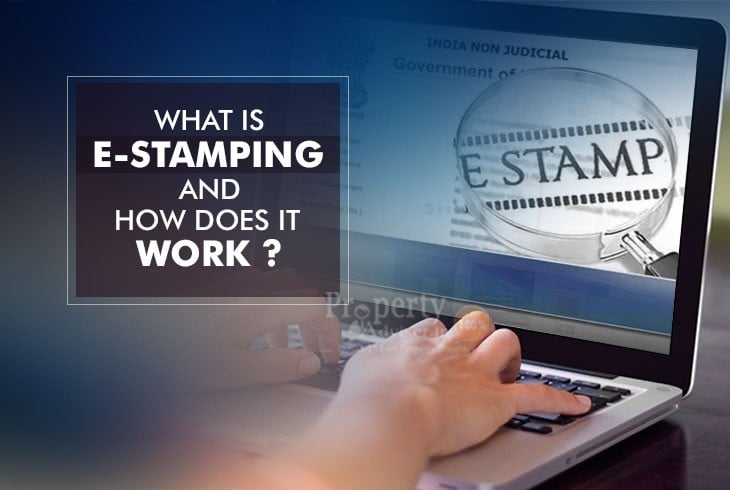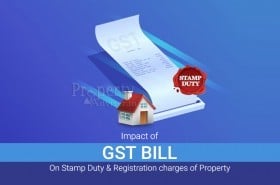E-stamping - What, Why & How
E-stamping is an important component of the property purchase or sale. In this article, we will understand e-stamping or electronic stamping, e-stamping ,e-stamping application form, how to fill e-stamp application form, e-stamp online, what is consideration price in e-stamp.
Before understanding e-stamping meaning, we need to understand what stamp duty is.
What is Stamp Duty?
When transactions like buying, selling, making deeds, leasing, etc. take place, there is a financial component associated with it, and also a duty that has to be paid to the government. Such transactions are securely documented on stamp papers that can be purchased from authorized vendors, the value of which would be dependent on what is ascertained by the state (or central) authorities, and based on the nature of the transaction. The money that has been paid to buy the stamp paper is called stamp duty and the said money goes to the government. Thus the stamp paper is the proof that duty has been paid to the government for the said transaction.
The stamp paper gives legal validity to the contract. In case the stamp duty is not paid, then the transaction is not legally valid, and cannot be produced before court of law.
Three Ways Stamp Duty Can Be Paid
- Traditional paper-based process.
- E-stamping.
- Using a franking machine.
E-stamping Meaning
The traditional paper based stamp process is prone to counterfeiting. You may remember the stamp paper scam that rocked the country a few years back.
Franking, on the other hand can be a cumbersome process, where contracts are written on non-stamp paper and then they are stamped at authorized centres after payment of the stamp duty.
To contain counterfeiting and human errors in the stamp paper process, and also to simplify the process, the government introduced e-stamping in 2013. E-stamping or electronic stamping is an electronic way of paying non-judicial stamp duty to the government.
E-stamp Online
So how is e-stamp online done? What is the process, where can we get the e-stamp online application form, how to fill the application form? Read on.
Where is E-stamping Available?
E-stamping or electronic stamping is currently available in 19 of the states in India. In fact, in a few states, for example, New Delhi, e-stamping is mandatory. For all e-stamps used in the country, the central government has appointed the Stock Holding Corporation of India Limited (SHCIL) as the Central Record Keeping Agency (CRA). SHCIL is responsible for executing e-stamping - including user registration, e-stamping applications and maintenance of records. SHCIL has designated authorised collection centres, or ACCs-scheduled banks for issuing certificates to users.
E-stamping Application Form
The next question in your mind would be if you want to do e-stamp online, where or how can you get an e-stamping application form? It is very simple.
- Go to the SHCIL website - www.shcilestamp.com
- Check if your state government allows e-stamping.
- If e-stamping is available in your state, download the e-stamping application form.
- Fill the e-stamping application form with the details of the parties involved and the transaction for which it is to be used. You can find information on the website on which transactions require stamping.
- Go to an authorised collection center (ACC). You can find the addresses of the collection centers on the website.
- Submit the form along with payment for the e-stamp certificate.
- You can pay in currency by cash, cheque or demand draft if it is done at the ACC. Online payment can be done on the SHCIL website using debit cards, credit cards, pay orders, RTGS, NEFT or through an account-to-account transfer.
- Upon submission of duly filled form and payment, your e-stamping certificate will be generated instantly, and handed over to you.
How to Fill E-stamping Application Form
You have to enter the following fields for filling the e-stamping application form.
- Application date.
- Whether the document is registrable or non-registrable.
- Document description - what is the purpose for which you are buying the e-stamp paper (whether sale of property, rent agreement, affidavit, etc)
- Property description.
- First party details (name, address, phone number, PAN and pincode). First party means the seller, owner, etc.
- Second party details (name, address, phone number, PAN and pincode). Second party means the buyer, tenant, transferee, etc.
- Stamp duty payment details - purchased by whom, paid by whom, payment info. (e-stamp paper can be purchased by either the first party or the second party).
After filling the e-stamping application form, you have to duly sign it, submit it and get the receipt.
E-stamp Verification
The SHCIL website has all the data. You can easily do e-stamp verification online by furnishing the information such as name of the state, Unique Identification Number (UIN), stamp duty type, and certificate issue date. E-stamp verification is thus a simple process on the website.
What is Consideration Price in E-stamp?
The consideration price in e-stamp is the total value of funds pertaining to any purchase/sale transaction entered between two or more parties.
Benefits of E-stamping
- It is convenient and easy.
- It can be generated within minutes.
- No need to pay additional charges as it happens with paper-based stamp
(in case the correct denomination paper is not available).
- E-stamping is tamper-proof.
- All data is saved by SHCIL.
- Authenticity can be verified on the website with the unique identification number.
Can We Get a Duplicate E-stamp Certificate?
In case you have misplaced your e-stamp certificate, a duplicate copy cannot be issued, and perhaps this is a drawback of e-stamping.
All in all, e-stamping is an easy and simple method, and is safe and tamper-proof.












